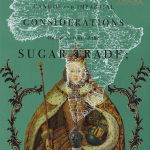Billy Gerard Frank
Colonial Imaginary NO. 4, 2025
screenprint with chine-collé
76 x 56 cm
29 7/8 x 22 in
29 7/8 x 22 in
edition of 20
Published by Glasgow Print Studio
£ 1,800.00
Own Art
As low as 10 interest-free monthly payments of £180.00 and no deposit.
Colonial Imaginary No. 4 juxtaposes a Blackamoor marble sculpture with a stately portrait of Queen Elizabeth I (1558–1603), who financed early slave-trading ventures led by John Hawkins, receiving both royal...
Colonial Imaginary No. 4 juxtaposes a Blackamoor marble sculpture with a stately portrait of Queen Elizabeth I (1558–1603), who financed early slave-trading ventures led by John Hawkins, receiving both royal ships and a share of the profits. The emblem of the Royal African Company—founded in 1660 and granted a crown-sanctioned monopoly over English trade along the West African coast — features prominently, exposing the deep entanglements of monarchy, commerce, and colonial violence.
Layered into the composition is a textual fragment drawn from Thomas Clarkson’s appeal for “a candid and impartial consideration of the sugar trade.” This phrase becomes a rhetorical pivot, highlighting tensions within the abolitionist movement: between reformers advocating gradual change and more radical voices (like Ottobah Cugoano, and Equiano), and fellow members of the Sons of Africa, who demanded the immediate and total abolition of slavery in all its forms.
Layered into the composition is a textual fragment drawn from Thomas Clarkson’s appeal for “a candid and impartial consideration of the sugar trade.” This phrase becomes a rhetorical pivot, highlighting tensions within the abolitionist movement: between reformers advocating gradual change and more radical voices (like Ottobah Cugoano, and Equiano), and fellow members of the Sons of Africa, who demanded the immediate and total abolition of slavery in all its forms.




